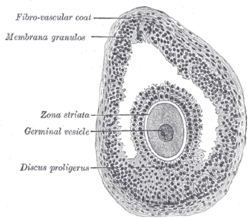Cumulus oophorus
| Cumulus oophorus | |
|---|---|

Section of vesicular ovarian follicle of cat. X 50. (Discus proligerus labeled at lower left.)
|
|
| Details | |
| Identifiers | |
| Latin |
Cumulus oophorus Discus proliger |
| FMA | 18659 |
|
Anatomical terminology
[]
|
|
The cumulus oophorus (Latin cumulus=heap, Greek oo=egg + phor=carrier; Latinized ending "-us"), also called discus proligerus, is a cluster of cells (called cumulus cells) that surround the oocyte both in the ovarian follicle and after ovulation. In the antral follicle, it may be regarded as an extension of the membrana granulosa. The innermost layer of these cells is the corona radiata.
This layer of cells must be penetrated by spermatozoa in order for fertilization to occur.
Functions of the cumulus oophorus include coordination of follicular development and oocyte maturation. Mechanisms of the latter include stimulation of amino acid transport and sterol biosynthesis and regulation of oocyte gene transcription.
It also provides energy substrates for oocyte meiotic resumption and promotes glycolysis.
In addition, it provides protection for the oocyte. Also used in cloning procedures
As a part of the process of in vitro fertilization, gene expression profiling of cumulus cells can be performed to estimate oocyte quality and the efficiency of an ovarian hyperstimulation protocol, and may indirectly predict oocyte aneuploidy, embryo development and pregnancy outcomes. Increased knowledge in these aspects is useful in, for example, embryo selection.
In gene expression profiling of cumulus cells, genes where increased expression is correlated with higher oocyte competence or better pregnancy outcomes include: HAS2, GREM1 and PTGS2.
...
Wikipedia
